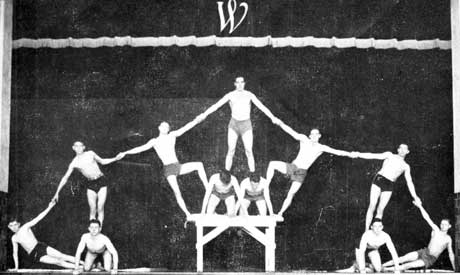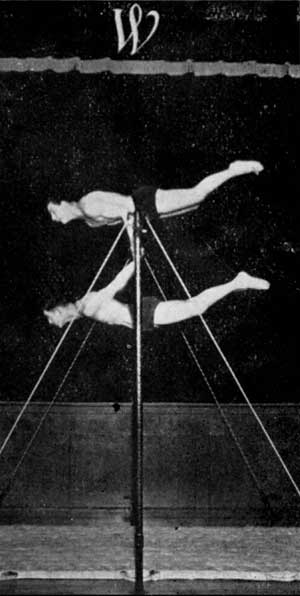
On Floor: James Fetzer, John Roberts, Fred Blythe, Kenneth
Goodman.
Second Row: Charles Fetzer, Joe Shannanahan, Bernard Han(s)on,
George Stahl, Gene Shannahan, Dale Gahring.
Top: Lawrence Ver Cande.
Under the direction of Instructor Francis Drury, a gym circus was held at the grade school gym in April of 1938. High bar work performed by Williamsburg resident Dr. Merlin Lewis, who was a University of Iowa letter winner in gymnastics, thrilled the audience with his high bar routine. The high school boys also performed on the high bar, presented a comedy skit, pyramid building and tumbling races. Stilt walking was handily done by Byron Knock. Billy Blythe was known as the ten year old tumbling wonder. Lester Fetzer and Dale Gahring performed springboard dives from seven feet in the air. The grand finale of the evening was the presentation of “tableaus.” These tableaus were “statue” scenes of Greek and Roman origin, such as a discus or javelin thrower or a wrestler, where the boys painted themselves with a white coating and the spotlight directed on them would make them look like real statues. The band played between acts and five clowns entertained the crowd. The clowns walked on the railing in the auditorium, climbed the basketball supports and for a short time stole the baton from band director Mr. Vietmeier and led the orchestra.
This would be the first of four annual appearances of the “Gymnastic Circus” held in April of 1938. Subsequent appearances were also in April of 1939 and 1940. This first circus was very well received. Very little equipment was available at the school for this first event. A high bar, a few small mats and a home made springboard comprised the equipment list.
In 1939 a 36 foot mat and side horse were purchased. The 1939 program became more sophisticated with printed programs that included photographs, more difficult stunts, more events and special demonstrations on the high bar by Dr. M.A. Lewis and Robert Parry. Dr. Lewis was recognized as the outstanding gymnast of the Big Ten Conference, his specialty being the high bar. How lucky these boys were to have the attention of Dr. Lewis. Robert Parry, a 1933 graduate of Williamsburg was high scorer for the gymnastic team at the University of Iowa in the previous two years and would become captain of the Iowa team in the fall of 1939. He was considered outstanding in his performance of high bar and flying rings and also was a very fine tumbler. Dr. Lewis and Robert Parry were inspirations to the Williamsburg tumblers. Performances on the high bar in 1939 were given by Henry “Hank” Zimpleman, Fred Blythe, Leighton Peirce and Lawrence Vercande. According to Hank Zimpleman, Robert Parry was a kind and generous man. He arranged for Hank to receive a scholarship in tumbling from the University of Illinois. Although Hank was very excited about it, Hank’s father wasn’t, telling Hank to forget it. This was a time when upper education was not considered to be better than getting out to “work”. Different times…and that’s the way it was.
First High School Gymnastics Meet Held in Williamsburg

Leighton Peirce & Henry Zimpleman
By 1940 climbing ropes and flying rings were equipment added to the gym. Robert Parry once again helped with practices in Williamsburg throughout the year and the April performance of the Gymnastic Circus. The tumblers would appear at halftime of basketball games as did the Drum and Bugle Corps. In April of 1940 Williamsburg would host the first high school gymnastics meet ever held in Iowa and would take a giant share of the placings. Schools competing included Roosevelt of Cedar Rapids, Burlington, Davenport and Williamsburg. Judges were the University of Iowa Coach, Baumgartner, Dr. M. A. Lewis and Robert Parry. Placings were determined by the number of points given to each by the three judges. In the side horse division Williamsburg took the first four places as follows: Bernard Hanson, John Roberts, Joe Shannahan and Lawrence Vercande. Williamsburg also took the first four places in the rings in this order: John Roberts, Dale Gahring, Eugene Shannahan and Lawrence Vercande. Individual tumbling awards went to Billy Blythe, first, Fred Blythe, second and Dale Gahring third, all Williamsburg. Davenport clinched the first three places in the high bar competition with Fred Blythe of Williamsburg taking fourth. For this time period Williamsburg certainly had one of the best gymnastic programs in the state and one of the few schools of its size to have gymnastics at all.
A parade headed by the Williamsburg Drum and Bugle Corps preceded the fourth and final gymnastic circus. Decorated bikes, a float with the pep band and business floats would all be part of the parade that streamed from downtown to the grade school. 300 spectators would attend this final circus. New acts included junior high tumblers performing in unison, hand balancing and a balance pole act by Fred Blythe and Donald Stone. Williamsburg claimed to be the only high school in the country using this balance pole equipment. Robert Parry again was the featured acrobat. The pep band furnished the music and clowns once again entertained the crowd. Not known at the time, this would be the last performance of the gymnastics and tumbling team. Francis Drury takes an assignment to Waterloo, the war starts and most sports are dropped. Gymnastics is never a team sport again in Williamsburg.